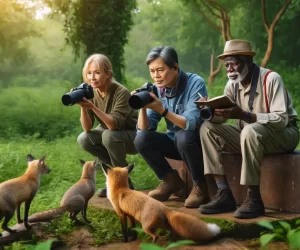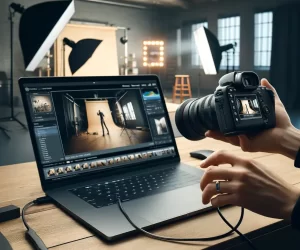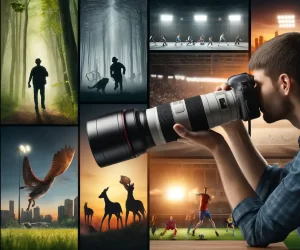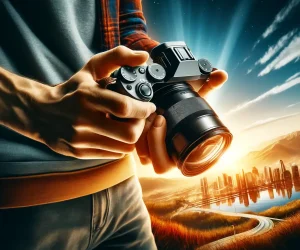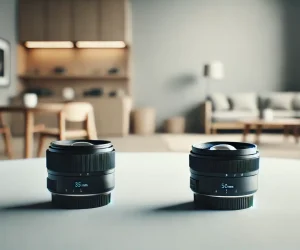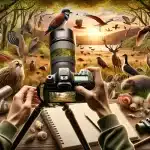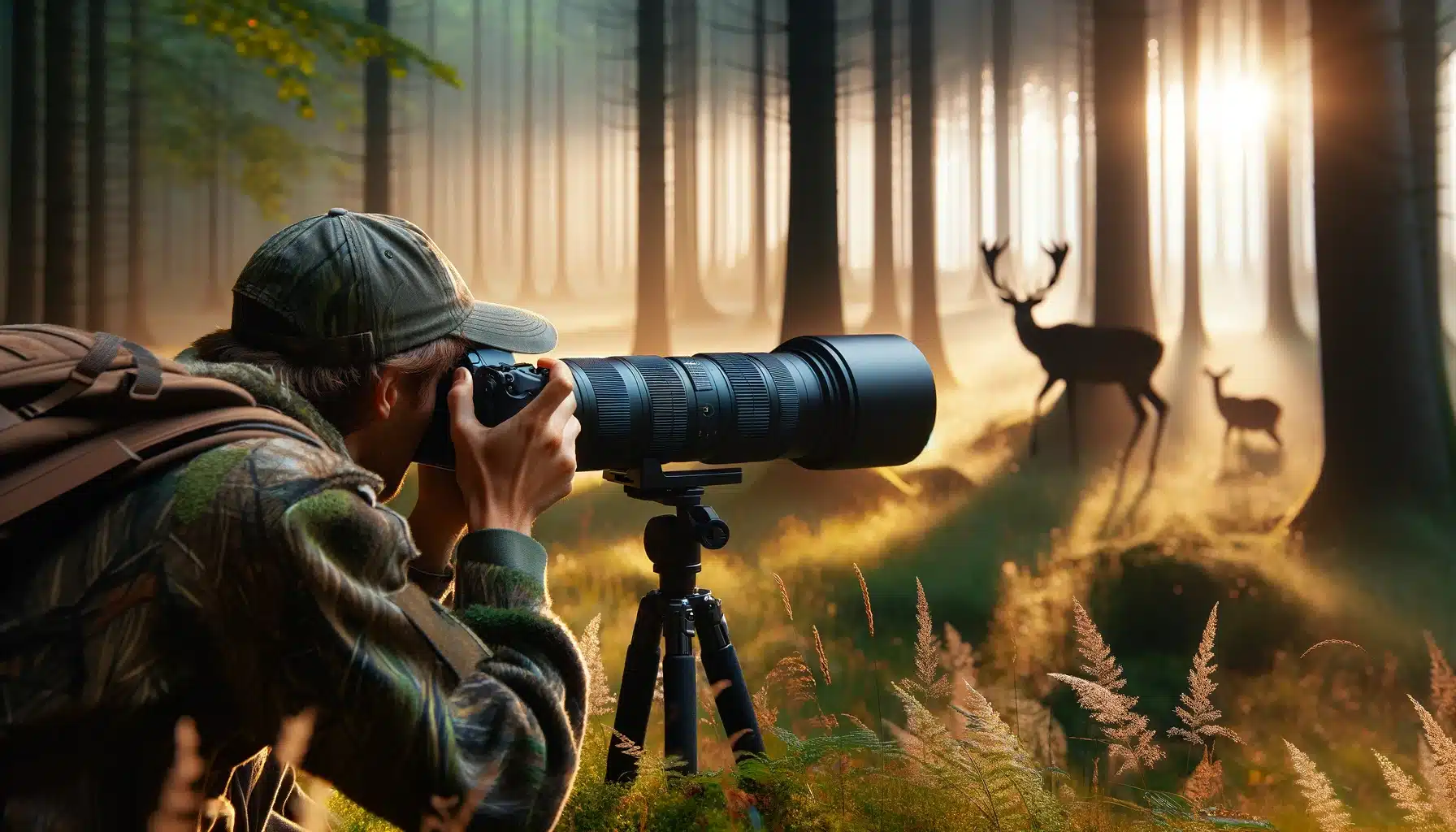
Embarking on a journey into the wild, photographers seek the Best Cameras for Wildlife Photography. It helps to to capture the essence of nature in its purest form. This article is your ultimate guide, designed to navigate through the myriad of camera options. It will ensure that you’re equipped with the right gear to freeze those fleeting moments into timeless pieces of art. Whether you’re tracking a bird in flight or waiting for the perfect sunrise over a serene landscape, the right camera can make all the difference.
Through the challenging landscapes of nature’s creatures, capturing photos of the wild requires more than mere patience. Thus, it calls for a camera that matches your prowess and augments your creative sight. We explore the realms of Nikon, Canon, Sony, and others, scrutinizing sensors, lenses, autofocus mechanisms, and more. These will guide you to your ideal companion for capturing the essence of nature.
Table of Contents
Best Cameras for Wildlife Photography: Professional Picks
| Feature/Camera | Nikon Z9 | Canon EOS R3 | Sony Alpha 1 | Nikon D850 | Canon EOS R5 |
|---|---|---|---|---|---|
| Sensor Type | Full-frame CMOS | Full-frame stacked CMOS | Full-frame stacked CMOS | Full-frame CMOS | Full-frame CMOS |
| Megapixels | 45.7 | 24.1 | 50.1 | 45.7 | 45 |
| Autofocus Points | 493 | Subject to lens | 759 | 153 (99 cross-type) | 1,053 |
| Continuous Shooting | 20 fps (RAW), 30 fps (JPEG) | 30 fps (electronic shutter) | 30 fps | 7 fps (9 fps with grip) | 12 fps (mechanical shutter), 20 fps (electronic) |
| Image Stabilization | Yes | Yes | Yes | No | Yes |
| ISO Range | 64-25,600 | Not specified | Not specified | 64-25,600 (expands to 32-102,400) | 100-51,200 (expands to 102,400) |
| Weight | 2.95 lbs (with battery and memory card) | Not specified | Not specified | 2.02 lbs (camera body only) | 1.62 lbs (incl. battery and memory card) |
| Notable Pros | High resolution, deep buffer, High autofocus | High shooting speed, innovative sensor design | High resolution, superior autofocus, high fps | Dynamic range, dual card slots, 4K video | Image quality, high-res sensor, robust stabilization |
| Notable Cons | Pricey, heavy | Dual card slots with different types | Very expensive | Heavier, lacks built-in stabilization and Wi-Fi | Complex menu, potential overheating in 8K |
Best Cameras for Wildlife Photography in Detail
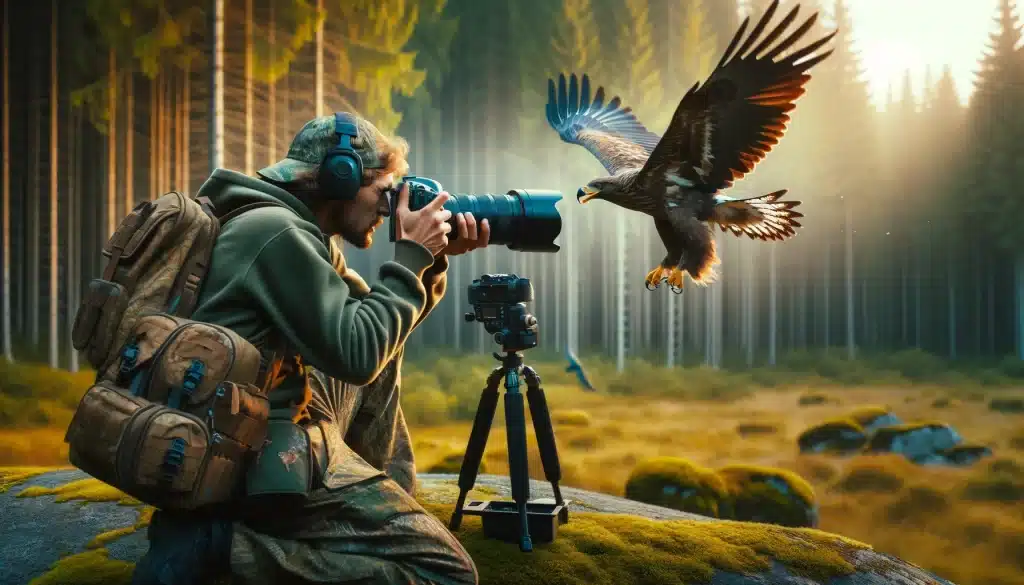
Nikon Z9: The Pro's Choice
The Nikon Z9 stands out as a top choice for professional wildlife photography. It has a 45.7MP full-frame sensor. Due to this, it delivers stunning image standard and impressive burst shooting speeds of up to 20fps in RAW and 30fps in JPEG. It’s equipped with AI-powered Subject Recognition autofocus, making it ideal for tracking fast-moving wildlife. The Z9’s robust build and advanced features come with a higher price tag. Thus, making it a premium option for serious photographers.
Canon EOS R3: Speed and Precision
The Canon EOS R3 is another excellent professional option, featuring a 24.1MP full-frame sensor and high-speed shooting capabilities at 30fps. Its back-illuminated design reduces rolling shutter distortion, ensuring sharp images even in challenging light conditions. The R3 combines the durability of the EOS-1D series with advanced mirrorless technology. It offers both speed and precision for photography.
Sony Alpha 1: One of the Best Cameras for Wildlife Photography
Sony’s flagship Alpha 1 boasts a 50.1MP sensor, providing exceptional detail and cropping flexibility. Its advanced autofocus system and high-speed shooting at 30fps make it a formidable tool for capturing wildlife in action. The Alpha 1’s impressive features, including Real-time Eye AF for birds and animals, position it as a top-tier camera for wildlife photography. Although, its high cost reflects its premium status .
Nikon D850: A DSLR Contender
For those preferring DSLR, the Nikon D850 is a strong contender. It offers a 45.7MP full-frame sensor with a wide ISO range for excellent performance across various lighting conditions. Its 7fps burst rate and robust weather-sealed body make it a reliable choice for outdoor wildlife shooting. However, it lacks built-in image stabilization, a feature to consider depending on your shooting style.
Canon EOS R5: Balancing Features and Usability
The Canon EOS R5, with its 45MP sensor and superior autofocus capabilities, is well-suited for both sports and wildlife photography. It offers robust image stabilization and high-speed continuous shooting, housed in a durable, weather-sealed body. Itt has potential overheating issues during extended 8K shooting and a complex menu system. Still, its overall performance and image standard are excellent for wildlife photography.
Budget and Compact Options
While the focus here is on professional picks, it’s worth noting that there are also more affordable and compact options for wildlife photography. Cameras like the Olympus OM-D E-M10 Mark IV offer a good balance of quality, portability, and price, making wildlife photography accessible to a broader range of enthusiasts.
Mirrorless vs. DSLR, which is the Best Cameras for Wildlife Photography
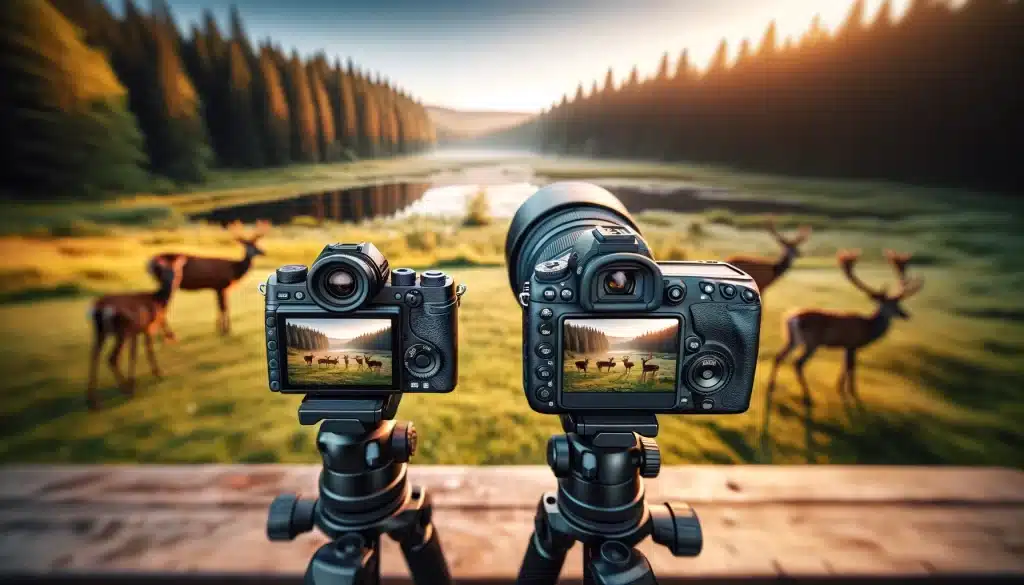
Choosing between mirrorless and DSLR devices for wildlife photography involves considering key aspects such as portability, shooting speed, and video capabilities. It’s crucial to review both types, as mirrorless cameras offer compact designs and rapid image capture, beneficial for the dynamic environment of wildlife photography, while DSLRs provide durability and extended battery life, important for long sessions in nature. Let’s delve into the key aspects to consider:
Best Cameras for Wildlife Photography on the basis of Image Stabilization
- DSLRs typically use lens-based image stabilization, which is effective but limited to specific lenses.
- Mirrorless cameras have an advantage with in-body image stabilization (IBIS), allowing for steadier shots across all lenses, crucial for capturing sharp images of fast-moving wildlife, especially in low light.
Video Capability
- While DSLRs can shoot top class video, they often fall short in autofocus performance during video recording.
- Mirrorless cameras excel in video features like 4K/8K resolution, high frame rates, and superior autofocus, making them more versatile for wildlife videography.
Viewfinder Experience
- DSLRs provide a real-time optical view through their viewfinder, giving a natural and lag-free view, essential for tracking wildlife.
- Mirrorless cameras use electronic viewfinders (EVF) that offer a digital preview with exposure adjustments, though they may suffer from lag and a less natural look.
Size and Weight for the Best Cameras for Wildlife Photography
- Mirrorless cameras are generally more compact and lighter than DSLRs, a plus for wildlife photographers trekking to remote locations.
- DSLRs tend to be bulkier, offering a larger grip and potentially more comfortable handling during long shooting sessions.
Battery Life for the Best Cameras for Wildlife Photography
- DSLRs have longer battery life due to less power consumption by optical viewfinders.
- Mirrorless cameras, despite having shorter battery life, are catching up with improvements in battery technology and optional battery grips.
Lens Flexibility and Selection for Best Cameras for Wildlife Photography
- DSLRs benefit from a mature system with a wide range of lenses, including many specialized options for wildlife photography.
- Mirrorless cameras are quickly expanding their lens offerings, with the advantage of more compact and lighter lenses due to a shorter flange distance.
Cost Considerations for the Best Cameras for Wildlife Photography
- Both DSLRs and mirrorless cameras span a wide price range, but mirrorless models can be slightly more expensive due to newer technology features.
Future Outlook and Advancements
- The trend is leaning towards mirrorless technology, with manufacturers focusing on developing this area. Mirrorless cameras are expected to continue evolving with features like global shutters, eye-control focus, and advanced video capabilities.
While DSLRs have long been favored for wildlife photography, mirrorless options are gaining ground due to their compact nature and advanced features. The choice between these should be guided by your specific needs and the wildlife environments you aim to capture. Considering both video and photo capabilities are essential in determining which type will best suit your photographic style and requirements.
Key Features of the Best Cameras for Wildlife Photography
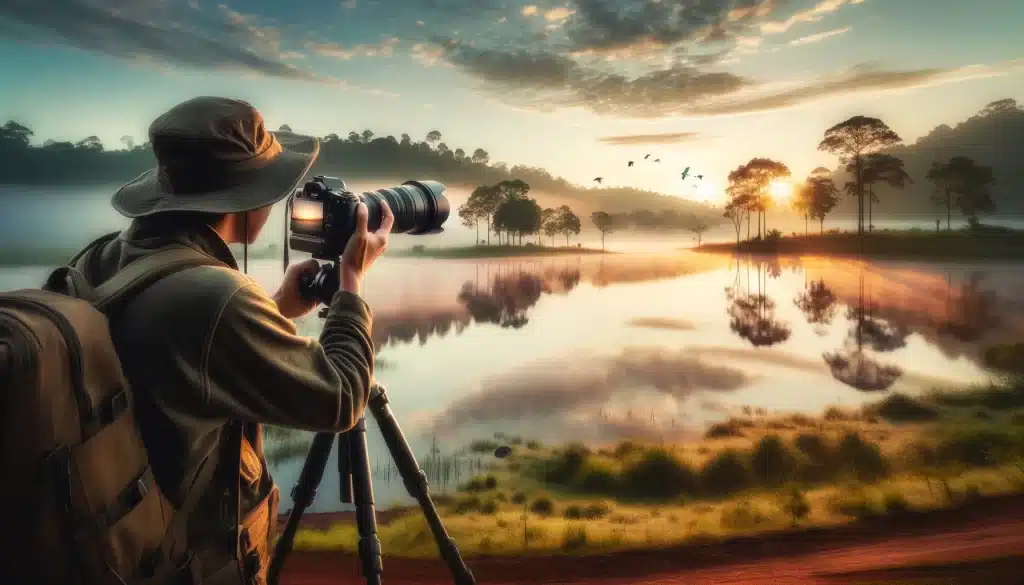
High Resolution and Image Standard
Top wildlife cameras like the Nikon Z9 and Sony Alpha 1 offer high-resolution sensors (45.7MP and 50.1MP respectively) that produce stunning image standard, crucial for capturing detailed wildlife shots.
Advanced Autofocus Systems
The Nikon Z9 with its 493-point autofocus system and Sony Alpha 1’s 759-point system, including AI-powered Subject Recognition and Real-time Eye AF, are designed to track fast-moving wildlife accurately.
Speed and Performance for Best Cameras for Wildlife Photography
Cameras such as the Nikon Z9 can shoot up to 20fps in RAW, and the Sony Alpha 1 offers 30fps continuous shooting, ensuring you never miss a critical wildlife moment.
Lens Compatibility and Range of the Best Cameras for Wildlife Photography
Having a wide range of compatible lenses is vital for wildlife photography to capture subjects at various distances. Mirrorless cameras like the Panasonic Lumix G9 II offer a huge range of lightweight lenses suitable for the task.
Build Standard and Durability
The robust and top class build of cameras like the Nikon Z9 ensures they can withstand the rigors of outdoor wildlife shooting environments.
In summary, the best cameras for wildlife photography combine high resolution, advanced autofocus capabilities, rapid shooting speeds, extensive lens compatibility, and durable build standard to meet the diverse demands of capturing wildlife in action.
Budget-Friendly Options: The Best Cameras for Wildlife Photography
For photographers looking to capture wildlife without breaking the bank, there are several budget-friendly cameras that still offer the necessary features and performance.
| Camera Model | Type | Features | Pros | Cons |
|---|---|---|---|---|
| Nikon D5300 | DSLR | 24.2MP resolution, 39 autofocus points | Affordable, lightweight, good connectivity | Limited to 5 fps, not best for speedy action |
| Canon EOS Rebel T7 | DSLR | 24.1MP sensor, hybrid autofocus system | User-friendly, beginner’s guide integrated, decent image quality | Not ideal for advanced photographers, limited shooting speed |
| Pentax K-70 | DSLR | 24.2 Megapixels, weather-resistant, 6 fps | Durable, suitable for tough conditions, shake-reduction feature | Moderate fps rate, additional accessories needed |
| Fujifilm X-H1 | Mirrorless | 24.3MP sensor, 14 fps, weather resistance | Fast shooting speed, high image quality, accurate autofocus with tracking | Heavier among mirrorless options |
| Sony a99II | DSLR | 42.4MP sensor, hybrid autofocus, 12 fps | High-resolution, weather-resistant, good for fast-moving subjects | Price on the higher side for budget options, weight |
| Nikon Z6 II | Mirrorless | 24.5MP sensor, 14 fps, dual processors | Strong low-light performance, minimal EVF blackout | Limited articulation, accessory costs |
| Olympus OM-D E-M10 Mark IV | Mirrorless | 20.3MP sensor, 5-axis image stabilization, compact design | Portable, effective stabilization, built-in flash | Low burst shooting with autofocus, no microphone support |
| Canon EOS M50 | Mirrorless | 24.1MP CMOS sensor, 10 fps, dual pixel CMOS AF | Strong EVF, user-friendly interface | Cropping in 4K video, shorter battery life |
| Sony Alpha 6400 | Type Mirrorless | 24.2MP sensor, 11 fps, 425 phase-detection AF points | Compact, fast autofocus, beginner-friendly | Battery drains quickly during continuous recording |
Capturing Standard: Image Specifications for Wildlife Shots
When venturing into the wilderness to capture its inhabitants through your lens, understanding the image specifications that lead to top class photographs is critical. The cornerstone of wildlife photography is the delicate balance of exposure settings, which include shutter speed, aperture, and ISO.
Shutter Speed
This is a priority in wildlife photography since animals are often on the move. A fast shutter speed is essential to freeze motion and avoid blurriness. Many photographers find a starting point of 1/500s to be a good balance between achieving sharp photos and maintaining enough light in the photograph.
Aperture
A wide aperture, such as f/2.8 or f/4, helps by allowing more light into the camera and creating a shallow depth of field, which beautifully blurs the background and focuses attention on the subject. However, if the animal is close or you need more of the scene in focus, you may need to narrow the aperture.
ISO
Keeping the ISO as low as possible will yield the cleanest images. Entry-level cameras usually perform well up to ISO 800, while more advanced cameras can handle higher ISO levels such as 3200 or 6400 without significant noise.
In-Body Image Stabilization (IBIS)
IBIS has become an indispensable tool, especially when hand-holding long lenses. Cameras with effective stabilization systems, like the Canon R5 and R6, enable sharp photos even at low shutter speeds like 1/20s, although you’ll typically need faster speeds for moving subjects.
Metering
Using evaluative metering helps the camera to automatically adjust exposure settings for a balanced shot. However, you may need to adjust exposure compensation manually if your subject is backlit or has very dark or bright plumage or fur that could mislead the camera’s light meter.
Autofocus Settings
A reliable autofocus system is vital. Modern cameras come equipped with advanced AF systems capable of eye and animal detection. The key is to choose an AF mode that suits the scene, whether it’s a single point for precise focus or a wider area for moving subjects.
Lens Quality
The lens is as important as the camera. Teleconverters can extend the reach of your lenses to bring distant animals closer, but be mindful that they may reduce the lens’s maximum aperture and slightly degrade image standard.
Remember that each scenario is unique, and adjusting these settings in harmony with the environment and the behavior of the animal is an art in itself. Always aim to understand and practice with your gear, as knowing it inside and out will dramatically improve your ability to capture striking wildlife images.
Advanced Techniques in Wildlife Photography
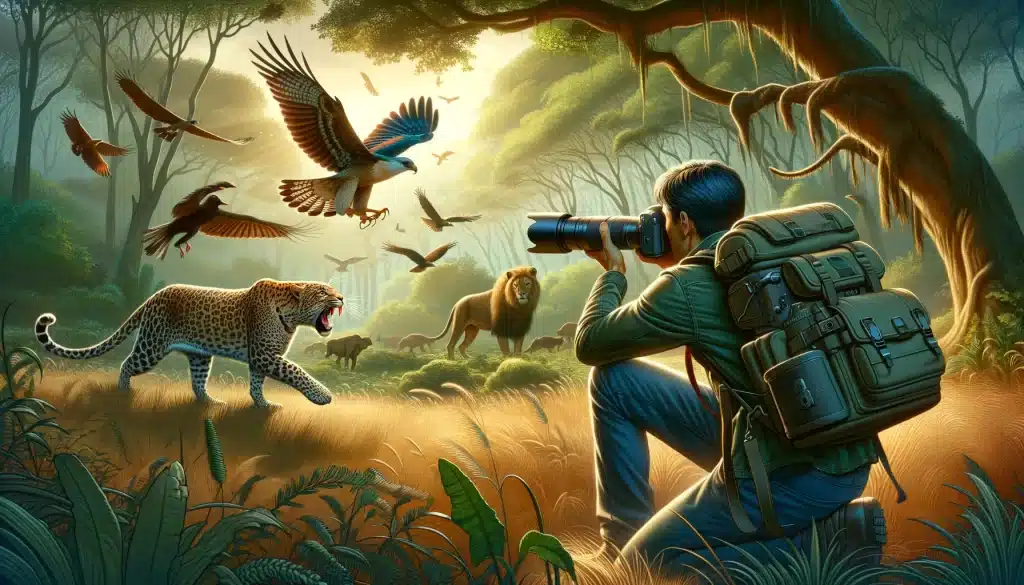
Enhancing your wildlife photography goes beyond just owning a decent camera and lens. It involves delving into more sophisticated methods that elevate the artistry and effectiveness of your images. Here’s a rundown of some advanced techniques that can help you take your wildlife photos to the next level:
Mastering Backlighting
Backlighting can transform a simple wildlife image into a dramatic one by highlighting fur or feathers from behind, creating a ‘rim-lighting’ effect. This technique requires the sun to be in front of you, casting light through and around your subject.
Embracing Wide-Angle Perspectives
Utilizing wide-angle lenses in wildlife photography can introduce the environment into your images, offering a unique perspective that telephoto lenses cannot provide. This might involve manual focus and remotely triggering the camera, but the results often justify the effort.
Applying Fill Flash
Using flash in wildlife photography, particularly fill flash, can illuminate shadows and balance harsh lighting conditions, like dappled light through a forest canopy. Done correctly, the flash will fill in the shadows subtly, enhancing the photo without making it obvious that artificial light was used.
Exploring High-Key Imagery
High-key photography involves overexposing the highlights in an image, intentionally blowing out whites to create a stark, artistic result. This technique often requires a completely white background, isolating the subject and giving the photo an ethereal quality.
Capturing Rain Streaks
Shooting in the rain can produce unique images with streaks that convey the mood and weather conditions, offering a different narrative compared to the usual sunny images.
Utilizing Slow Shutter Speeds with Birds in Flight
Instead of always opting for fast shutter speeds with birds in flight, consider using low speeds to introduce motion blur. This conveys the movement and speed of your subject, with the potential of getting a sharp focus on the head against a blurred background.
Crafting Reflection Pools
Not a technique involving the camera itself, but building a reflection pool can enable you to capture stunning images of wildlife reflected in water, adding an element of symmetry and beauty to your photos.
Familiarity with Your Gear
Knowing your camera and lens inside out can make the difference between capturing a fleeting moment or missing it. This includes understanding the limits of your shutter speed, focus points, and ISO settings.
Understanding Wildlife Behavior
Being able to predict an animal’s behavior can greatly increase your chances of capturing a great photo. Spending time observing your subjects and understanding their patterns is key.
Compositional and Exposure Experimentation
Knowing the rules of composition and exposure is essential, but so is the willingness to experiment and break them to create unique and eye-catching images.
Each of these techniques demands practice and patience but can significantly enrich the visual storytelling of your wildlife photography. Always remember to practice ethical photography, especially when using techniques like flash, to ensure the well-being of the wildlife you are capturing
The Future of Wildlife Photography Gear
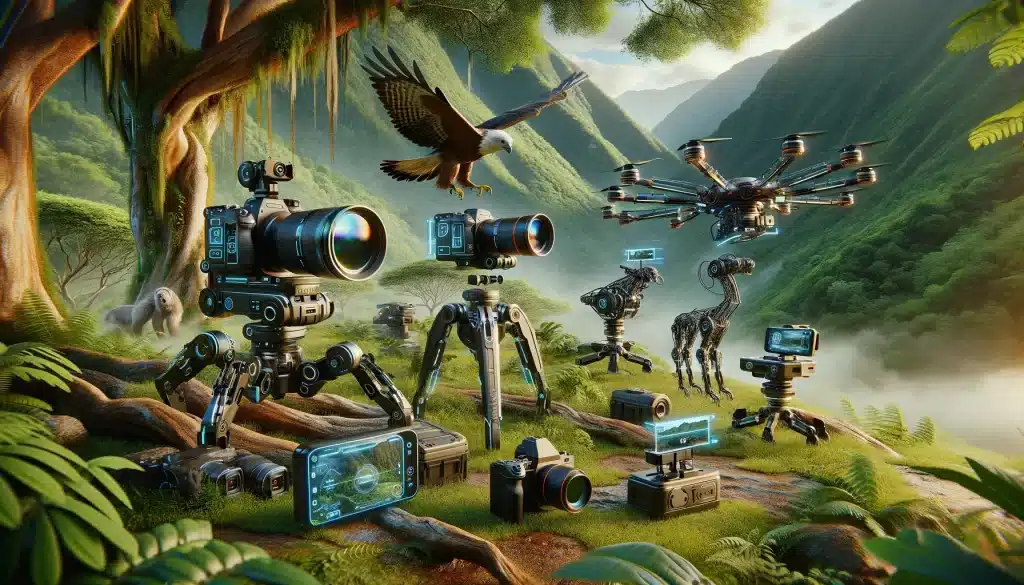
The coming years in wildlife photography gear show a vibrant trajectory of innovation and democratization. The most significant developments expected to impact the field include:
Specialized Lenses
Just as macro and astrophotography have benefited from specialized lenses, wildlife photography is likely to see lenses designed for the unique challenges it presents. Innovations like Canon’s autofocus tilt-shift patent hint at a future where technology is molded to meet the specific creative demands of wildlife photographers.
Cost-Effective Top class Lenses for the Best Cameras for Wildlife Photography
The rise of third-party lens manufacturers offering quality at a lower price point means that professional-grade gear will become more accessible to a broader range of photographers. Brands like Viltrox exemplify this trend with their competitively priced yet high-performing lenses.
Augmented Reality (AR)
AR’s potential in wildlife photography could revolutionize the way we experience images, providing interactive, immersive experiences that go beyond traditional photo presentations.
Drone Photography
With advances in drone technology, wildlife photographers can capture previously unreachable perspectives, promising more breathtaking aerial shots of wildlife and their habitats.
Authenticity and Nostalgia
Trends suggest a move towards unfiltered, authentic images and a revival of retro aesthetics. In wildlife photography, this could mean a renewed appreciation for images that tell a true story of the natural world, potentially steering away from heavily edited representations.
Mobile Photography
The quality of mobile camera technology continues to improve, encouraging wildlife photographers to utilize the convenience and immediate nature of smartphone cameras for spontaneous shots.
360-Degree Interactive Photography
While not AR, 360-degree photography allows for interactive viewing experiences, which could be applied to wildlife photography to create immersive visual stories.
As wildlife photography gear evolves, we can expect a harmonious blend of cutting-edge technology and a return to the essence of photography. The future seems to promise more tools that combine technical excellence with creative freedom, enabling photographers to explore the natural world in new and exciting ways.
Accessories for the Best Cameras for Wildlife Photography
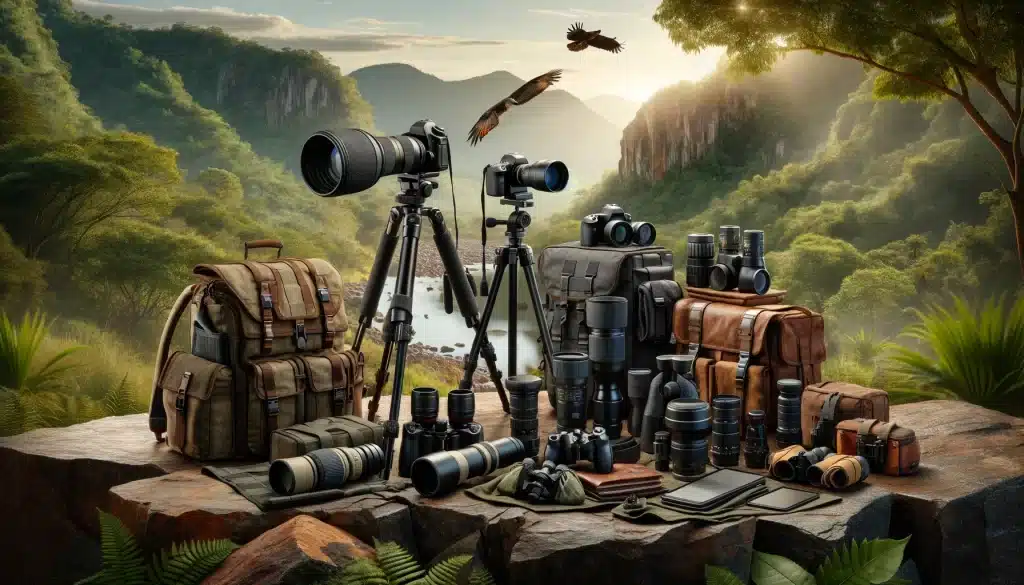
In the realm of wildlife photography, having the right accessories can make a significant difference in the field. Here are some essential camera accessories that every wildlife photographer should consider:
Bean Bag, Used in the Best Cameras for Wildlife Photography
A bean bag is an essential accessory, especially in safari vehicles with metal frames, for stabilizing your camera and long telephoto lens. It’s quick to set up and move, which is critical in wildlife photography where timing is everything.
Gimbal Head
For better pan and tilt control of your heavy camera setup, a Gimbal head is recommended over a ball head. It provides smoother movement, which is crucial for tracking animals.
Monopod
When you’re trekking through forests and need to reduce fatigue, a monopod is a practical alternative to a tripod. It provides support for your camera without the added bulk. Carbon fiber monopods are lighter and a popular choice.
Lens Extenders/Teleconverters
Wildlife often appears far away, and getting closer isn’t always an option. Lens extenders or teleconverters, such as the 1.4x or 2x, increase the reach of your lenses. They do reduce the maximum aperture and slightly decrease image standard, but the trade-off is often worth it for the additional reach.
Rain & Dust Cover
A high-quality rain cover for your camera and lens is crucial for protection against the elements. Opt for a camouflage color to remain inconspicuous in the wild.
Camera Bag
A rugged camera bag that fits the size restrictions for airplane travel and has enough space for your camera body, lenses, and accessories is a must-have.
Memory Cards
Carry multiple high-capacity memory cards with fast write speeds to match your camera, ensuring you never run out of space during intensive shooting sessions.
Portable Hard Drive
A rugged portable hard drive, like an SSD, is advisable for backing up your images, especially during extended trips.
Lens Coat
A camouflage lens coat helps blend your gear with the surroundings, minimizing the chance of disturbing wildlife, and also provides additional protection for your lens.
Cleaning Kit
A camera cleaning kit with a lens brush, pen, air blower, and cleaning cloth is necessary for maintaining your gear, especially after a day’s shoot in dusty or dirty environments.
Bandana
A bandana is useful for protecting your face from dust, especially when traveling in an open jeep on safari.
Binoculars
Binoculars are invaluable for scouting and observing wildlife. They don’t take much space and are handy for locating subjects from a distance.
Headlamp
A good headlamp is essential for early morning or late evening treks to and from your safari vehicle. Opt for one with USB charging for convenience.
These accessories will not only help protect your gear but will also enhance your capability to capture the perfect wildlife shot. Ensure to choose great products that can withstand the rigorous demands of wildlife photography.
Evaluating APS-C : One of the Best Cameras for Wildlife Photography
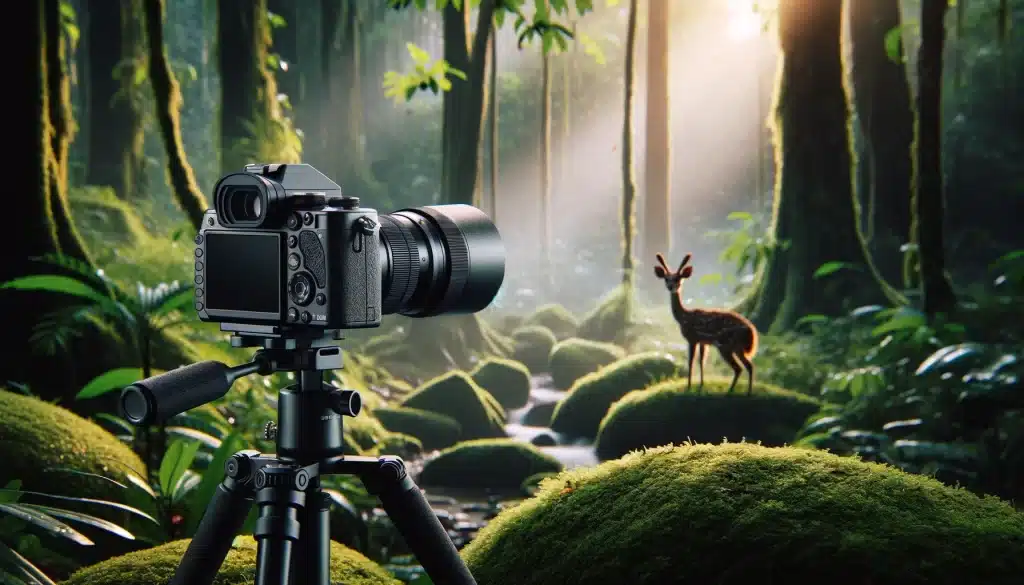
As we explore the APS-C camera market suitable for capturing fast action, we must look at models that have received positive reviews for their burst capabilities, sensor performance, and overall reputation in the photography world.
Sony Alpha a6600
The Sony Alpha a6600 is a leading choice with its 24.2-megapixel sensor, ensuring clear images of detailed scenes. With a burst shooting ability of 11 frames per second and real-time eye focus tracking, this camera is adept at capturing momentary events. Its compact design is also ideal for photographers moving through varied landscapes.
Fujifilm X-H2S
The Fujifilm X-H2S is noted for its adaptability and dependability in rugged conditions. It features a 26.1-megapixel sensor and a burst rate of 15 frames per second with a mechanical shutter. Its seven stops of Internal Body Image Stabilization help mitigate camera shake, crucial for shooting at extended focal lengths.
Canon EOS R7
The Canon EOS R7 offers a 32.5-megapixel sensor, delivering detailed images. It stands out with a 1.6X crop factor for additional telephoto reach, essential for capturing distant subjects. Its burst mode can reach 30 frames per second with an electronic shutter, making it a robust tool for action shots.
Nikon Z50
The Nikon Z50 provides an 11 frames per second burst rate and a 20.9-megapixel sensor. It is designed to endure harsh environments and features a silent photography mode, beneficial for capturing easily startled subjects.
Canon EOS 7D Mark II
Often discussed as one of the best for action due to its 10 fps burst rate and durable construction, the Canon EOS 7D Mark II’s autofocus system is a highlight, ensuring crisp and clear images in dynamic settings.
These APS-C offer the necessary speed along with high-resolution sensors and sophisticated autofocus mechanisms. They come with distinct features and price points, catering to a range of preferences, ensuring photographers can find a suitable camera for their action photography needs.
Frequently Asked Questions for the Best Cameras for Wildlife Photography
Which camera is mostly used for nature shoots?
The Nikon D850 is often used for nature shoots due to its robust build, excellent sensor performance, and reliable autofocus system. Its versatility and high resolution make it a great choice for capturing detailed subjects in natural settings.
What is the best image quality for nature shoots?
A great image standard for nature shoots often comes from cameras that can shoot in raw format, allowing for greater post-processing flexibility. A camera with a full-frame sensor and a high resolution, such as the Canon EOS 5D Mark IV, is known for producing raw files with excellent detail and dynamic range.
What is the best cheap camera for nature photography?
The Nikon D5600 is considered a great budget option for nature photography. It offers good performance in a compact size, with a decent APS-C sensor, and the ability to shoot in raw, providing good value for its price based on many reviews.
Is mirrorless or DSLR better for nature?
Both mirrorless and DSLR systems can be great for nature photography, but mirrorless cameras are often preferred for their lighter weight, compact size, and fast shooting capabilities. However, DSLRs like the Nikon D500 are still favored for their optical viewfinder and battery life, making the choice depend on personal preference and specific shooting conditions.
Final Thoughts: The Best Cameras for Wildlife Photography
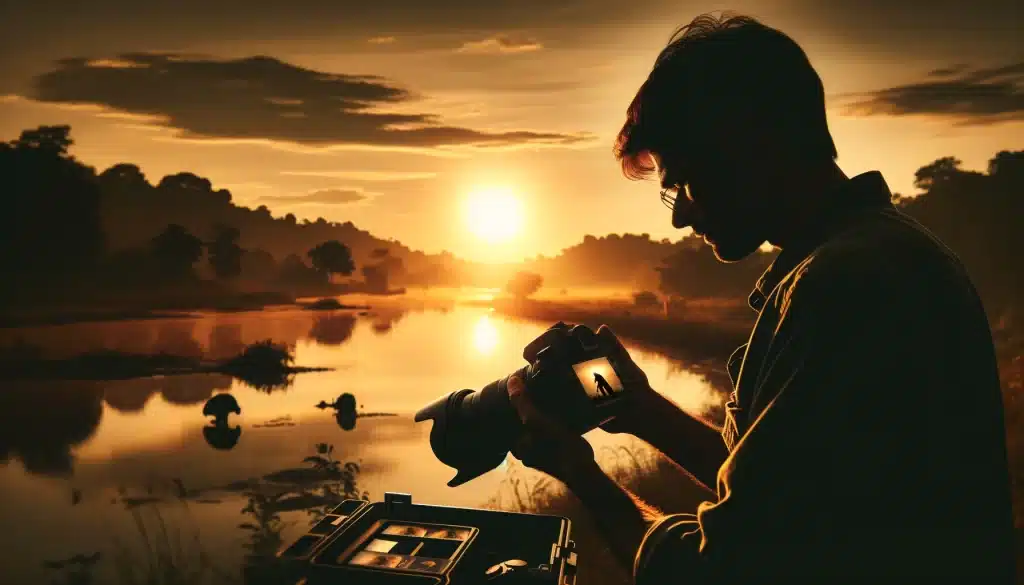
In my journey capturing the essence of nature, I’ve come to appreciate the nuanced capabilities of various cameras. Utilizing the Nikon D850, I’ve been able to capture the fleeting moments of a bird in flight with precision, showcasing the intricate details of its feathers. The camera’s reliable autofocus system and the ability to shoot in raw format have been pivotal in my work. Through my experiences, I’ve learned that the right equipment, coupled with skill and patience, leads to stunning captures.
For those looking to enhance their skills in nature photography, understanding the tools and techniques is just the beginning. I encourage you to delve deeper into the art and science of photography through our comprehensive courses. Enhance your skills in post-processing and learn to bring out the best in your captures with our Photoshop Course and Lightroom Course. Join us, and transform your passion into breathtaking works of art!
If the “Best Cameras for Wildlife Photography” article has helped you, then Like and Share it with your friends!
Have a nice photoshoot!
Read more about:
Course
Light Effect Photoshop
Lightroom Course 2024
Adobe Photoshop Course
Photo Editing Course
Get the latest version of Photoshop & Lightroom


Download Your Free Guide Now!
Discover the secrets of photography with our printable guide! Master essential techniques like aperture, shutter speed, and ISO to create stunning images. Get your free printable PDF now and start turning your snapshots into masterpieces!



